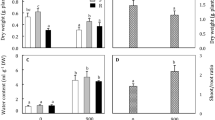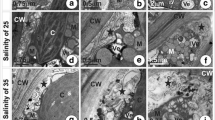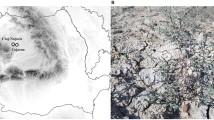Abstract
Beta vulgaris ssp. maritima (L.) occurs naturally along the Atlantic coasts of western Europe and along the coasts of nearly all Mediterranean countries (Letschert, 1993). To be able to survive in these habitats, the sea beet has developed mechanisms, which enable it to overcome saline stress. Tolerance to salinity is determined by a number of separate but interrelated mechanisms which operate at different levels of tissue structure to control the distribution of salt and other solutes within the plant and to maintain a gradient of water potential through the plant from the soil to the atmosphere (Gorham, 1992). The balance between water and salt uptake could be maintained by reducing transpiration, but at the expense of reduced carbon fixation and reduced growth rate (Gorham, 1996). Under salt stress, the reduction of growth is greater than the decrease in photosynthesis (Cheeseman, 1988). Salinity affects carbon assimilation because of a smaller leaf area rather than a reduced rate of photosynthesis (Klenke et al. in preparation). The reduction of leaf area is among the mechanisms salt includer species use in order to minimise the evaporating surface (Koyro and Huchzermeyer, 1999a) and consequently increase their water content leading to succulence. In the sea beet leaf succulence is a consequence of salt and water accumulation which induce changes in leaf structure, especially the increase of the volume of the palisade and spongy parenchyma cells (Koyro and Huchzermeyer, 1997).
Access this chapter
Tax calculation will be finalised at checkout
Purchases are for personal use only
Preview
Unable to display preview. Download preview PDF.
Similar content being viewed by others
References
Archer, S.D., McDonald, K.A. and Jackman, A.P.: Effect of light irradiance on the production of sulfolopids from Anabaena 7120 in a fed-bach photobioreactor. Appl Biochem Biotech 1997; 67: 139–52.
Cheeseman, J.M.: Mechanisms of salinity tolerance in plantes. Plant Physiol 1988; 87: 547–50.
Daoud, S., Koyro, H.-W and Harrouni, M.C.: 2003. Page 41 this volume.
Flowers, T.J.: Physiology of halophytes. Plant Soil 1985; 89: 41–56.
Flowers, T.J., Hajibagheri, M.A. and Clipson, N.J.W.: Halophytes. Quaternary Rev Biol 1986; 61 (3): 313–37.
Gorham, J.: Grass response to salinity. Desertified grasslands: their biology and management 1992; 165–80.
Gorham, J.: Mechanisms of salt tolerance of halophytes. In Choukr-Allah, R., Malcom, C.V. and Hamdy, A., editors. Halophytes and biosaline agriculture. Marcel Dekker, Inc. New York, 1996; 31–53.
Hampe, T and Marshner, H.: Effect of sodium on morphology, water relations and net photosynthesis of sugar beet leaves. Z Pflanzenphysiol Bd 1982; 108: 5. 151–62.
Kelly, D.B., Goodin, J.R. and Miller, D.R.: Biology of Atriplex. In Sen, D.N. and Rajpurohit, K.S., editors. Tasks for vegetation, Vol. 2. 1982; Chap. 5.
Klenke, I., Koyro, H.-W and Huchzermeyer, B. Salinity affects chloroplasts maturation in maize. Plant physiology (in preparation).
Koyro, H.-W. and Huchzermeyer, B.: The physiological response of Beta vulgaris ssp. maritima to sea water irrigation. In Lieth, H., Hamdy, A. and Koyro, H.-W. Water management, salinity and pollution control towards sustainable irrigation in the mediterranean region. Special volume: Salinity problems and halophyte use. Technomack, bari, 1997; 29–50.
Koyro, H.-W. and Huchzermeyer, B.: Salt and drought stress effects on metabolic regulation in maize. In Pessarakli, M., editor. Handbook of plant and crop stress 1999a; 843–77.
Koyro, H.-W and Huchzermeyer, B.: Influence of high NaC1Salinity on growth, water and osmotic relations of the halophyte Beta vulgaris ssp. maritima — development of a quick check. In Hamdy, A., Lieth, H., Todorovic, M. and Moschenko, M., editors. Halophyte uses in different climates I, 1999b; 89–103.
Koyro, H.-W., Wegmann, L., Lehmann, H. and Lieth, H.: Adaptation of the mangrove Laguncularia racemosa to high NaC1 salinity. In Hamdy, A., Lieth, H., Todorovic, M. and Moschenko, M., editors. Halophyte uses in different climates I, 1999; 43–64.
Kuiper, D. and Kuiper, P.J.C.:Lipid composition of the roots of Plantago species: response to alteration of the level of mineral nutrition and ecological significance. Physiol Plant 1978; 44: 81–86.
Letschert, J.P.W. Beta section Beta: biogeographical patterns of variation, and taxonomy. Wageningen Agricultural University. Papers 93–1, 1993.
Longstreth, D.J. and Nobel, P.S.: Salinity effects on leaf anatomy, consequences for photosynthesis. Plant Physiol 1979; 63: 700–3.
Marschner, H. and Possingham, J.V.: Effect of K+ and Na+ on growth of leaf discs of sugar beet and spinach. Z Pflanzenphysiol 1975; 75: 6–16.
Stuiver, C.E.E., Kuiper, P.J.C., Marschner, H. and Kylin, A.: Effects of salinity and replacement of K+ by Na+ on lipid composition in two sugar beet inbred lines. Physiol Plant 1981; 52: 77–82.
Terry, N. and Ulrich, A.: Effects of potassium deficiency on the photosynthesis and respiration of leaves of sugar beet. Plant Physiol 1973; 51: 783–6.
Terry, N., Waldron, L.J. and Taylor, S.E.: Environmental influences of leaf expansion. In Dale, J.E. and Milthope, F.L., editors. The growth and functioning of leaves. Cambridge University Press, Cambridge, 1983.
Editor information
Editors and Affiliations
Rights and permissions
Copyright information
© 2003 Springer Science+Business Media Dordrecht
About this paper
Cite this paper
Daoud, S., Koyro, HW., Harrouni, M.C., Schmidt, A., Papenbrock, J. (2003). Salinity tolerance of Beta vulgaris ssp. maritima. Part II. Physiological and biochemical regulation. In: Lieth, H., Mochtchenko, M. (eds) Cash Crop Halophytes: Recent Studies. Tasks for Vegetation Science, vol 38. Springer, Dordrecht. https://doi.org/10.1007/978-94-017-0211-9_5
Download citation
DOI: https://doi.org/10.1007/978-94-017-0211-9_5
Publisher Name: Springer, Dordrecht
Print ISBN: 978-90-481-6256-7
Online ISBN: 978-94-017-0211-9
eBook Packages: Springer Book Archive




